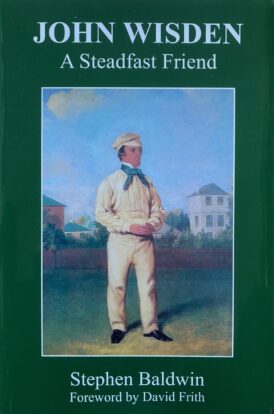John Wisden: A Steadfast Friend
Martin Chandler |Published: 2025
Pages: 272
Author: Baldwin, Stephen
Publisher: Sussex Cricket Museum
Rating: 4 stars

The name of John Wisden is synonymous with the game of cricket. His enduring fame comes from his eponymous Cricketers’ Almanack. First published in 1864 and about to complete an unbroken run of 162 annual appearances. The almanack itself has spawned books, and even had a biography of its own but this one, published more than 140 years after his death in 1884, is the first full biography of the man whose name is a byword amongst cricketing bibliophiles.
And of course there is a great deal more to the life of John Wisden than the Almanack. The year it first appeared is significant in that it was the year after Wisden played his last First Class fixture. In those days Test cricket was still more than a decade away, and it was another year before a 16 year old lad named William Gilbert Grace would make his bow in First Class cricket.
So Wisden’s performances do not much impact on the statistical tables that now grace his Almanack, but he was one of the leading players of his day. Primarily he was a bowler who once took all ten wickets in an innings, and hit the stumps each time, but in addition he made two First Class centuries in an era when such tall scores were exceptionally rare.
Born in 1826 in Brighton the telling of Wisden’s story as fully as it appears is testament to the depth of research that author Stephen Baldwin has carried out over a number of years. The Wisden family do not seem to have left anything behind in terms of diaries, scrapbooks or the like, but Wisden’s cricketing deeds were extensively covered in the press, and business and company records add to the story as well.
Wisden’s father was a builder, and business acumen was clearly not lacking in the family, although for many years Wisden earned his living mainly from cricket. Almost half of his First Class appearances were for Sussex, but he also played for both the famous wandering professional teams of his time, the All England Eleven and the United England Eleven. He also appeared extensively for the Players and sides styled as England and was a member of George Parr’s side that toured North America in 1859.
As well as Parr Wisden’s life regularly came into contact with all of the great cricketing names of the time including William Clarke, the various members of the Lillywhite family as well as the likes of Alfred Mynn, Thomas Box and Nicholas Wanostrocht (aka ‘Felix’).
It would be fair to say that the narrative is inevitably a little dry, restricted as it is by the rather matter of fact style of reporting employed at the time, but the fact that such a full picture of Wisden’s travels is available nonetheless makes for an absorbing story even if Wisden’s own account of his dealings with William Clarke at the time he was a prime mover in the setting up of the breakaway United England Eleven, and of his business relationship with William Liilywhite, would doubtless have added much to the story.
That said one suspects that Wisden would have kept any controversial views to himself. For many years he was heavily involved in the Cricketers’ Fund Friendly Society, a charity, and his dealings with that and in business generally seem to have been beyond reproach. The sub-title of the book, A Steadfast Friend, would seem to be entirely appropriate.
The Launch of the Almanack is chapter 18 of 21 so just four chapters cover the genesis of cricket’s greatest publishing phenomenon, the development of the various strands of Wisden’s business and the last twenty years of his life. Sadly he died at just 57, in 1884. Wisden had never married so left no descendants. If he had who knows what sort of personal archive they might have curated for the benefit of future generations.
A biography of John Wisden was, until now, one of the major gaps in the literature of the game. But perhaps it as well that we have had to wait so long, as the lengthy gestation period has given Baldwin the opportunity to thoroughly research the many sources he has located. The result is a thoroughly rounded picture of a name that will resonate through cricket history as long as the game is played. For what it is worth, bearing in mind that such important figures as David Frith and Roger Packham have respectively contributed a foreword and an introduction, I agree entirely with both.






Leave a comment